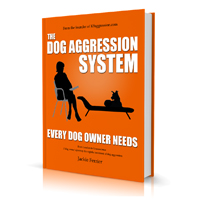Your cart is currently empty!
6 Other Ways to Keep Others Away From Your Dog
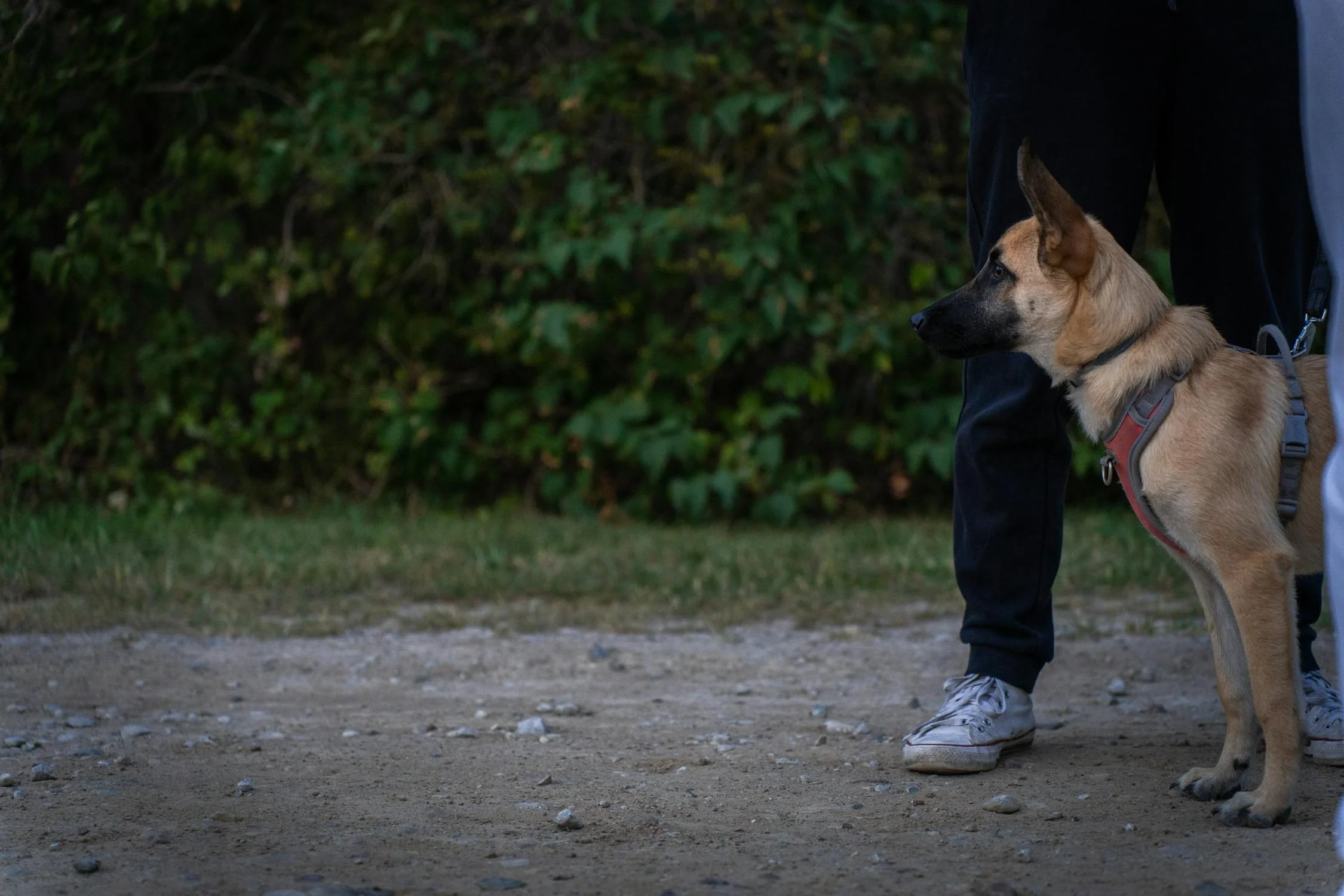
Of course we rely on our voice to communicate to other that they should keep their distance. However there are some of the pitfalls dog handlers run into that sometimes makes this simple solution not so simple.
Pitfalls
- Sometimes simply you don’t see others coming. You may miss someone if you are looking at your dog, reaching for a treat or paying attention to something else.
- It’s hard to confront other people for many people, especially if you are sensitive to other’s feelings or shy.
- We’ve been made to feel bad about our dog’s problem behaviour in the past and are reluctant to broadcast it if we can avoid it.
- People may think your dog is fine because they’re not reacting (yet) and ignore you what you say (see suggestion on how to handle this below)
- Some people believe that all dogs like them and will approach anyway!
- Raising your voice can signify to your dog there is something to worry about.
- Telling people to keep away may contribute to social conflict.
- Talking to or yelling at other dogs may do nothing to deter other dogs determined to approach your dog

So we’ve put some suggestions together on what else has worked for other people who might help you and your dog.
Aids To Help Keep Others away
The following suggestions are split between dealing with approaching people and approaching dogs and can be combined. Each one tends to work either on dogs or people, but not often both. Below we discuss the pros and cons of each. The links to Amazon are affiliate links which means K9aggression.com gets a small percentage from Amazon (at no cost to you – Amazon pays us) should you click on a link and decide to buy. But we encourage you to buy only things you think will be useful to you.
TIP: You don’t have to say your dog is aggressive. But it’s your job is to keep everyone around you safe. Try saying your dog needs space, that they are anxious or that they aren’t friendly. Many people are grateful to be informed. It’s when people don’t know and suddenly your dog reacts that causes the most issues.
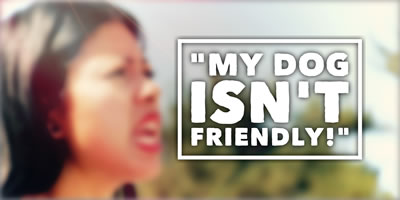
1. Deterring People: Scare People Off With a Muzzle
This is a double edge sword. Muzzles worry most people so this is a good way to keep people away from your dog. On the other hand they worry people. You don’t want your neighbours to start a campaign against you, or worst try to provoke your dog so they have something to complain to the authorities about. On the other hand if you have a good relationship with them, you can simply let them know your dog is anxious and needs space and a muzzle is a good way to scare people off.
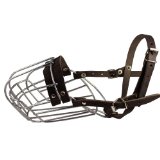
We’ve written a comprehensive article on muzzles for dogs that bite which will give you an idea of which kind of muzzles might be suitable. But any dog can learn to wear a muzzle. They don’t have to be aggressive.
PROS
- Muzzles are associated with biting and this taps into people’s natural fears causing them to stay away naturally.
- Tool can be useful to preventing bites giving dog handlers added confidence.
- Frees you up to focus on your dog.
CONS
- May alarm other dog owners.
- May cause some irritation on the dog’s face.
- Has to be trained to develop positive associations with the muzzle.
- Does not deter dogs.
- May lead dog owners into a false sense of security, believing that the problem is fixed. Dogs can still cause physical harm even while wearing a muzzle. Continuing to subject a dog to anxiety provoking situation which is bad for dog’s over all health and welfare.
- Does not work with all people.
Check out comprehensive article on muzzles for dogs that bite for recommendation on what to look for.
2. Deterring People: Visual Caution Cues
Wearing something the easiest, most passive way to let people know they should give you and your dog space. We recommend you combine this with what other strategy you use.
Shirts for dog handlers
Shirts are an easy, passive way to communicate. We had these ones designed using familiar caution or stop imagery so that people understood it even before they read the words.
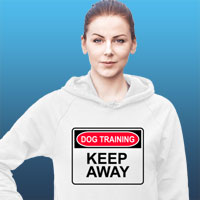
PROS
- Catches the attention of people easily.
- No risk.
- Non-confrontational, passive, non-personal way to communicate, can easily add to any other tactic you may use.
- Does not require the attention of the dog handler.
- Requires no operation on behalf of the handler.
- You dog is unlikely to develop negative associations with using one.
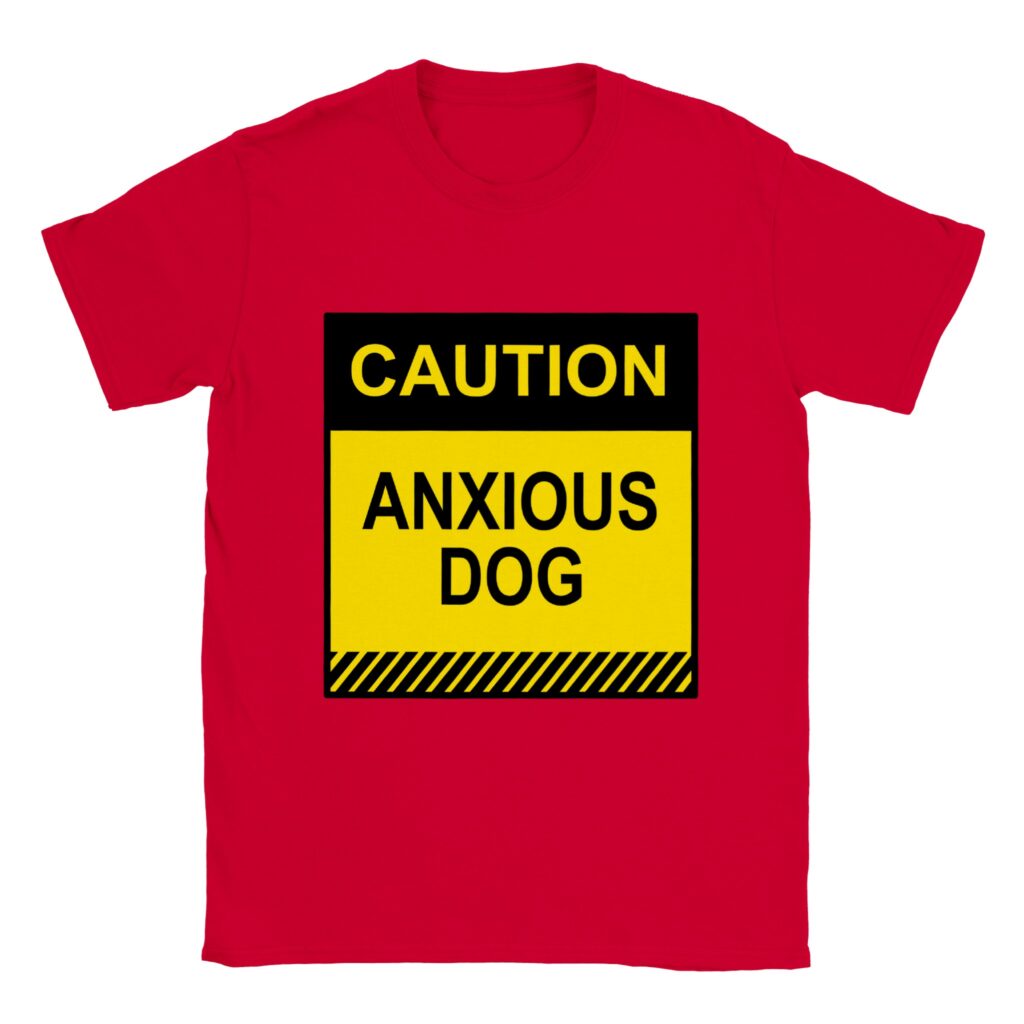
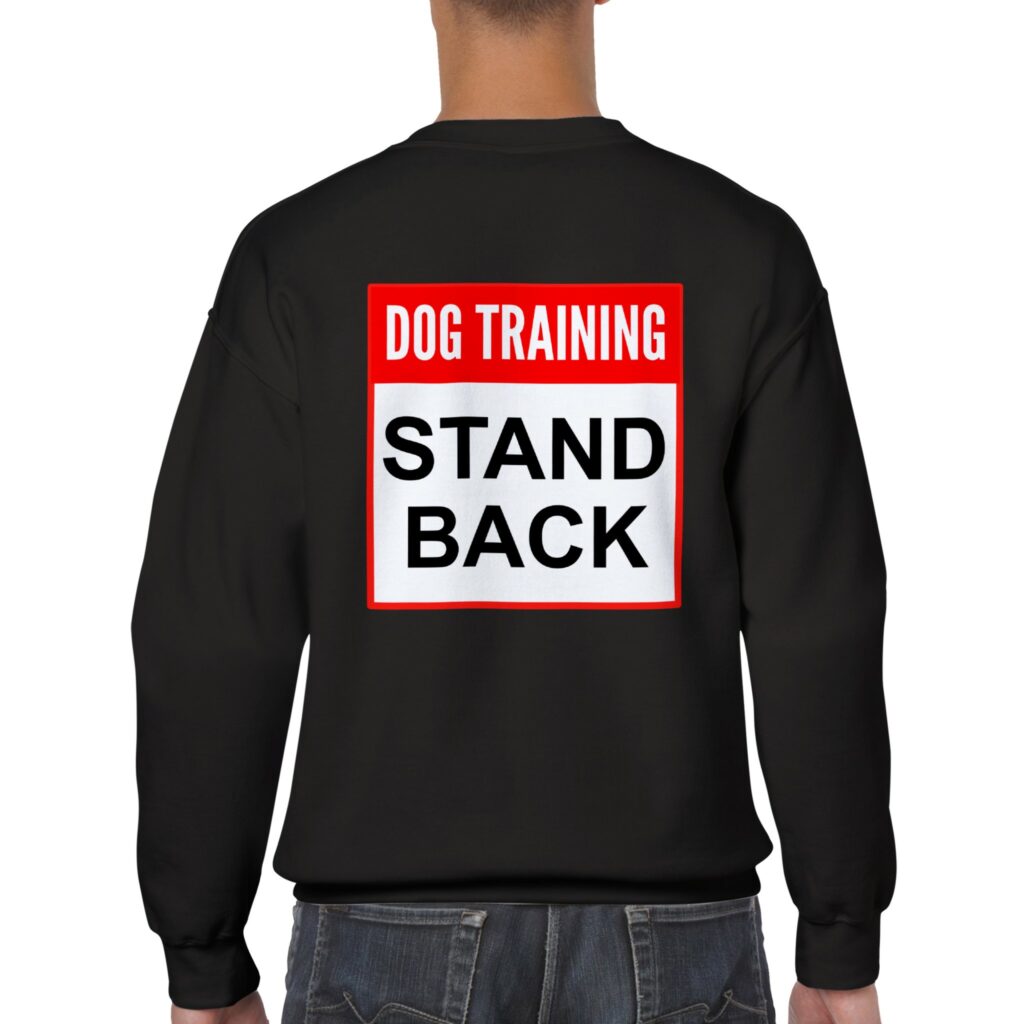

Where to get them: The K9aggression.com Shop
CONS
- People may overlook the shirt by focusing only on the dog.
- Obviously doesn’t deter off leash dogs!
Coloured Harnesses and Leashes
Harness and leashes such as this CAUTION Red Harness and Leash seen on Amazon (affiliate link) may prove helpful for you.
PROS
- Catches people’s the attention.
- Requires no operation on behalf of the handler.
- Dog is unlikely to develop negative associations with using one.
CONS
- May be viewed just as a designer leash from a distance.
- People may not know what the leash means.
- Not the easiest to read lettering on leashes and harnesses.
- Does not deter off-leash dogs.
3. Approaching Dogs: Keep Away with Distasteful Smells
We know what your thinking: But my dog LOVES distasteful smells. That may be, but we are talking about smells dogs find distasteful.
This product is for dogs. We haven’t heard of a product for humans yet. We don’t think it will be invented any time soon.
Spray deterrents
Petsafe Sprayshield Animal Deterrent Spray
PROS
- Non-harmful.
- Spray deterrents like citronella or water don’t hurt other dogs but they can be distasteful to other dogs.
- Deterrent to off-leash dogs.
CONS
- May be cumbersome to hold and operate at the same time as holding a leash, treats and clicker.
- May alarm other dog owners creating social conflict.
- Other dog owners may assume it is pepper spray.
- May blow into your own dog’s face
- If the other dog is aggressive, may evoke defensive aggression
4. Approaching dogs: Startling visually
Starting animals is not our best strategy. It can scare dogs and this may change a positive mood to a negative one. Additionally, you might create fear when there wasn’t any before. The last thing you want to have your dog associate fear with other people or animals.
But sometimes necessary when a dog is bent on approaching yours and his owner is helpless to stop them and your dog has the potential to cause harm, or your dog’s anxiety is quite high.
Whatever you have around at the time may work including waving your arms around. But if you are doing for a walk, one of the easiest may be a spring load umbrella that pops open when you press a button.
Spring Loaded Umbrellas
PROS
- You may already own one.
- Dramatic gesture may ward off others dogs without causing harm (if not too close).
- Can be a deterrent to off-leash dogs.
CONS
- This may alarm some dogs into responding aggressively
- May be cumbersome to hold and operate at the same time as holding a leash, treats and clicker.
- May cause injury to either dog.
- Unlikely to deter people.
- May alarm other dog owners concerned about their dogs causing social conflict.
5. Approaching Dogs: Startle with Sound
Again, startling is not the great choice.The last thing you want to have your dog associate fear with other people or animals. But sometimes you have no choice especially if there is a fight or an attack brewing.
Sound deterrents primarily work on dogs. While sound is not exactly a deterrent for people, it will certainly catch their attention and may cause them to reevaluate the situation.
People have used air horns to back off dogs, but many of these can be quiet loud so we don’t feel comfortable in making a recommendation for one. Other people have used cans of pennies, garbage can lids, or pebbles in a plastic bottle. We discuss this in the cons below, but the biggest problem with using this is the effect it will have on your dog.
PROS
- May deter other dogs without causing physical harm.
CONS
- Need to desensitize your dog to the sound to create positive associations in a variety of situations.
- Even doing so, may cause additional stress to your dog.
- May be quickly associated with the approach of other dogs which may make the problem worse.
6. Approaching Dogs: Distract The Other Dog
Treats and Toys
We know it sounds like crazy-talk, but throwing down food on the ground (or even at the dog) has distracted an off-leash dog more than once. It CAN cause issues in dog parks however but if your dog has issues with others, you should not be going to a dog park.
PROS
- You may already be carrying treats.
- May help distract other off leash dogs from approaching giving you more time to move away.
CONS
- May cause issues with other dogs at a dog park.
- Your own dog may think you are throwing the food or a toy for him or her.
- If the other dog is anxious, reactive, aggressive or simple too focused on your dog, the treats and toys may be completely ignored.
- Some dog owners get very upset when other people give treats to their dog
Here is an example of stopping dogs with treats
Remember – a dog who is sufficiently motivated to charge your dog may ignore the teats. On the other hand, a dog who is simply friendly or curious may be stopped this way.
Have a Plan
If you have an anxious, reactive or aggressive dog, you need to do you best to prevent your dog from becoming more anxious. You can’t do this effectively if you aren’t prepared.
Plan where you are going
Spend some time thinking about the least likely places to experience conflict. If you have a car, you might want to drive them somewhere new. If your dog is only aggressive toward other dogs, consider taking them to a place where dogs are not often seen, such as a mall parking lot.
Plan when to go
You might find leaving a half hour later or earlier will help you avoid certain situations.
Plan your tools
When you see that other person or dog and your heart starts pumping and you start to tense up, what are you going to do?
One suggestion is to have a treat bag on you that is easy to dip your hand into if you need to throw them at another dog.
The best ones we’ve used are the ones that are hinged and can be opened or closed with the flick of a finger.
PetSafe Treat Pouch Sport, Black
In addition you might find using a head halter can be really beneficial especially if your dog is prone to lunging or simply gets fixated on other people or dogs. This tool can really help you gain control over your dog’s head. Learn more about using a head halter for an aggressive dog.
Plan your response
Know what you want your dog to be able to do instantly and practice it long before you need it.
- Practice grabbing your treats or umbrella or noisemaker
- Think about what you’ll say
- Practise being “Jolly”
- Practice useful commands and exercises
Plan your Training
Asking your dog to sit can be very helpful as a sitting dog is less likely to get other dogs concerned. However, unless your dog has a lot of space, sitting at the end of a lead might make your dog feel trapped.
Below we have suggestion on the two easiest and in our opinion most useful commands to practice.
Easy to teach behaviors every dog owner of a shy, reactive or aggressive dog should practice
If you are trying to treat an anxious, reactive or aggressive dog, you might know it’s critical to your dog’s success that your dog does not go “over threshold”. (To learn more about why, see more about how anxiety relates to aggression and why we need to treat it) and the importance of getting your dog’s attention at the earliest stage of arousal.
- “Look” or “Watch Me”
- Turn on the spot
1. The “Look” or “Watch” Command
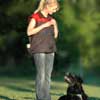
While it doesn’t stop other people or dogs, having your dog look at you when you say “Look” or “Watch” can be really helpful when you are out with your dog. It distracts your dog from paying attention to the threat and it refocuses your dog on you. That way you can let him or her know what they should be doing next.
Teaching “Look”
- Say the command or cue word
- Bringing a treat (that your dog knows is in your hand) up to your eyes
- Rewarding him or her with the treat.
- Repeat
As your dog starts to predict what is going to happen with enough repetitions, you can
- Keep the treat hidden in the other hand
- Bring your treat-free hand up to your face.
- Reward your dog for looking at you
- In time you can do less and less of a gesture to your face, but continue to reward your dog each time.
Practice frequently in as many different situations as you can think of in order for it to become automatic. Once it’s automatic, your dog will do it without having to think about it.
Here are the elements you should vary when you practice. In fact you can incorporate these during any kind of training. Always create a situation where the dog is most likely to succeed, and then only make it slightly more challenging as they succeed.
2. Turning on command/cue
One of the easiest things to do is to turn right around and head the other way. If your dog has caught sight of the other person or dog, remember to act jolly. It’s easier to transfer anxiety into excitement than it is transferring anxiety into being relaxed. This will help the both of you.
Make sure you turn frequently and abruptly at different times during your walks so your dog never associates it with seeing another person, or animal. But before you do, say a command (or cue) word so that your dog learns that word predicts a change of direction, and then if necessary call his name. Tossing your dog a reward for following you or allowing his play tug-of-war and play with a ball will make it more fun.
Here is an excellent video by 4 Paws University on how to incorporate this when dealing with strangers.
Elements to vary during training
Location
Practice in each room, all around the outside of your home, at various places on your walk. Start with the easiest place your dog can manage it and little by little increase the difficulty.
Voice
Pitch, loudness, etc. Your voice will change according to your mood. If your tense when you see that other person or dog, your dog will hear it in your voice.
Body
Walking, sitting, standing, bending over, arms up, arms out, with leash, without leash. etc.
Distractions
What occurs immediately before? Does your dog see a person, another dog, a cat? Perhaps a car goes by, the wind picks up or a bell goes off?
ADVERTISEMENT
The Dog Aggression System Every Dog Owner Needs E-book
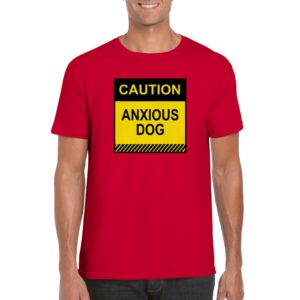
Anxious Dog Shirts only available in our shop
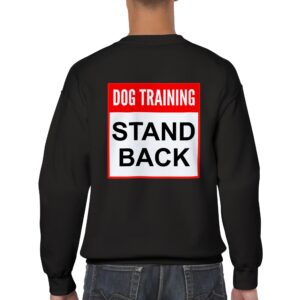
Keep people away with our Stand back shirts

